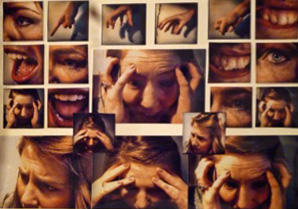Schizophrenia
Coming away from this visit I felt compelled to understand the true nature of this illness. The poignant true story of John Nash the famous schizophrenic mathematician who inspired the film ‘A Beautiful Mind’, inspired me to create a collage of photographs in an effort to characterzse some of the feelings possibly experienced by an individual sufferer.
I felt photography was an appropriate way to capture emotion through lighting and facial expression. The centre of the piece shows a number of faces exploring the fear, isolation and uncertainty of the schizophrenic. Encircling this are individual hands, eyes and mouths. These sense organs represent the hallucinations and the stigma dominating the mind.
The feeling of life drawing in on you, unable to run away, not sure what is real and what is not real. These are all concepts I wanted the audience to perceive when viewing my collage.
As clinicians making the decision to deprive someone of their liberty is not something to be taken lightly, removing privilege and free will. The sufferer and indeed every patient must be treated in a holistic manner and ultimately as a whole person.

This piece of art skilfully captures the chaotic confusion experienced by the schizophrenic patient. The fragmented images portray the struggle of a lifelong suffering, as they reflect the decomposition of the patient’s mind who can hallucinate and lose control over their thoughts. By including images of hands, and not just the face, the impact on the patient’s whole being is portrayed. The repeated images of various body parts also emphasise this sense of confusion.
This piece of art really drew my attention because it has a lot going on. The artwork has a lot of faces with differed expressions. The expressions are very extreme (from happy to anxious). The artwork reflects confusion like the confusion going on in the patient and their wife’s minds. They do not want to talk about the illness but they know that it exists. They are anxious, the patient thinks he might be a burden to his family and all these thoughts cause the confusion.
This work of art captured my attention, because it’s so wild and filled with pure and extreme emotions. I can see emotions like fear and confusion clearly on the face, and the hands convey a strong feeling of anger. With the collage of different pictures, the multiple aspects of Schizophrenia and the result of a scattered mind are portrayed accurately. I think the choice of medium: very clear, close-up photography and the presentation in form of a collage truly capture the essence of Schizophrenia.